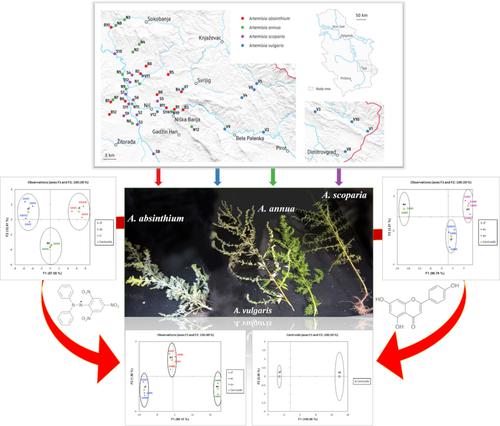当前位置:
X-MOL 学术
›
Chem. Biodivers.
›
论文详情
Our official English website, www.x-mol.net, welcomes your feedback! (Note: you will need to create a separate account there.)
Chemometric Approach to the Composition of Flavonoid Compounds and Phenolic Acids and Antioxidant Potential of Artemisia Species from Different Habitats
Chemistry & Biodiversity ( IF 2.9 ) Pub Date : 2022-10-31 , DOI: 10.1002/cbdv.202200365 Jovana D Ickovski 1 , Biljana B Arsić 1 , Milan N Mitić 1 , Milan B Stojković 1 , Milan M Đorđević 2 , Gordana S Stojanović 1
Chemistry & Biodiversity ( IF 2.9 ) Pub Date : 2022-10-31 , DOI: 10.1002/cbdv.202200365 Jovana D Ickovski 1 , Biljana B Arsić 1 , Milan N Mitić 1 , Milan B Stojković 1 , Milan M Đorđević 2 , Gordana S Stojanović 1
Affiliation

|
Four Artemisia species from Serbia were selected for the study: A. annua L., A. absinthium L., A. vulgaris L. and A. scoparia Waldst. et Kit. because of the proven excellent action in treating certain medical conditions and diseases. A. absinthium L., A. vulgaris L., A. annua L. and A. scoparia Waldst. et Kit. collected from different habitats across Serbia (48 samples in total) were studied from the statistical aspect considering the phenolic and flavonoid contents, compositions, and antioxidant activities of methanol extracts in correlation with the soil type. The components were identified using HPLC (High Performance Liquid Chromatography), while antioxidant activities were determined by seven assays (TP (Total phenolic content), TF (Total flavonoid content), DPPH (2,2-diphenyl-1-picrylhydrazyl) radical-based, ABTS (2,2′-azino-bis(3-ethylbenzothiazoline-6-sulfonic acid)) radical cation-based, FRAP (Ferric Reducing Antioxidant Power), TRP (Total Reducing Power), and CUPRAC (Cupric Reducing Antioxidant Capacity). The results were processed using five statistical methods (PCA (Principal Component Analysis), ANOVA (Analysis of Variance), MANOVA (Multivariate analysis of variance), DA (Discriminant analysis), and AHC (Agglomerative Hierarchical Clustering)). Principal component analysis enabled very well separation of the analyzed Artemisia species based on the content of total phenolics, total flavonoids, and the values obtained from antioxidant tests, but not on the individual compounds identified and quantified by HPLC. The MANOVA analyses showed that for A. scoparia and A. annua there was a significant effect of soil type on the total phenolics, total flavonoids, and antioxidant tests. In contrast, for A. vulgaris and A. absinthium, that effect was not significant. Additional MANOVA analyses showed a significant effect of soil type on phenolic and flavonoid compounds in the case of A. vulgaris, A. annua, and A. absinthium. The overall correct classification rate of all samples of four investigated Artemisia species by the discriminant analysis was 81.25 % using the training sample and 72.92 % the cross-validation results based on TP, TF, and antioxidant tests, but a much lower based on selected compounds identified and quantified by HPLC. MANOVA analyses based on particular Artemisia species show that soil is a significant factor affecting the measurable variables.
中文翻译:

化学计量学方法研究不同产地蒿类黄酮类化合物和酚酸的组成及抗氧化潜力
研究选择了来自塞尔维亚的四种蒿属植物: A. annua L.、A. Absinthium L.、A. vulgaris L. 和A. scoparia Waldst。等套件。因为在治疗某些医疗状况和疾病方面已被证明具有出色的作用。A. Absinthium L.、A. vulgaris L.、A. annua L. 和A. scoparia Waldst。等套件。考虑到甲醇提取物中酚类和黄酮类化合物的含量、组成和抗氧化活性与土壤类型的相关性,从统计角度对从塞尔维亚不同生境采集的甲醇提取物(共48个样品)进行了研究。使用 HPLC(高效液相色谱法)鉴定成分,并通过七项测定(TP(总酚含量)、TF(总黄酮含量)、DPPH(2,2-二苯基-1-三硝基苯肼基)自由基)测定抗氧化活性。 ABTS(2,2'-连氮基双(3-乙基苯并噻唑啉-6-磺酸))自由基阳离子系、FRAP(铁还原抗氧化能力)、TRP(总还原能力)、CUPRAC(铜还原抗氧化能力) )。结果使用五种统计方法(PCA(主成分分析)、ANOVA(方差分析)、MANOVA(多元方差分析)、DA(判别分析)和 AHC(凝聚层次聚类))进行处理。主成分分析能够根据总酚类、总黄酮类化合物的含量以及抗氧化测试获得的值,很好地分离所分析的蒿属物种,但不能基于 HPLC 鉴定和量化的单个化合物。多元方差分析表明,对于蒿属植物,土壤类型对总酚、总黄酮和抗氧化测试有显着影响。相比之下,对于A. vulgaris和A. asinthium来说,这种效果并不显着。额外的多元方差分析分析表明,土壤类型对A. vulgaris、A. annua和A. asinthium的酚类和类黄酮化合物有显着影响。通过判别分析,使用训练样本对所调查的四种蒿属所有样品的总体正确分类率为81.25%,基于 TP、TF 和抗氧化测试的交叉验证结果为 72.92%,但基于所选化合物的分类正确率要低得多通过 HPLC 进行鉴定和定量。基于特定蒿属物种的多元方差分析表明,土壤是影响可测量变量的重要因素。
更新日期:2022-10-31
中文翻译:

化学计量学方法研究不同产地蒿类黄酮类化合物和酚酸的组成及抗氧化潜力
研究选择了来自塞尔维亚的四种蒿属植物: A. annua L.、A. Absinthium L.、A. vulgaris L. 和A. scoparia Waldst。等套件。因为在治疗某些医疗状况和疾病方面已被证明具有出色的作用。A. Absinthium L.、A. vulgaris L.、A. annua L. 和A. scoparia Waldst。等套件。考虑到甲醇提取物中酚类和黄酮类化合物的含量、组成和抗氧化活性与土壤类型的相关性,从统计角度对从塞尔维亚不同生境采集的甲醇提取物(共48个样品)进行了研究。使用 HPLC(高效液相色谱法)鉴定成分,并通过七项测定(TP(总酚含量)、TF(总黄酮含量)、DPPH(2,2-二苯基-1-三硝基苯肼基)自由基)测定抗氧化活性。 ABTS(2,2'-连氮基双(3-乙基苯并噻唑啉-6-磺酸))自由基阳离子系、FRAP(铁还原抗氧化能力)、TRP(总还原能力)、CUPRAC(铜还原抗氧化能力) )。结果使用五种统计方法(PCA(主成分分析)、ANOVA(方差分析)、MANOVA(多元方差分析)、DA(判别分析)和 AHC(凝聚层次聚类))进行处理。主成分分析能够根据总酚类、总黄酮类化合物的含量以及抗氧化测试获得的值,很好地分离所分析的蒿属物种,但不能基于 HPLC 鉴定和量化的单个化合物。多元方差分析表明,对于蒿属植物,土壤类型对总酚、总黄酮和抗氧化测试有显着影响。相比之下,对于A. vulgaris和A. asinthium来说,这种效果并不显着。额外的多元方差分析分析表明,土壤类型对A. vulgaris、A. annua和A. asinthium的酚类和类黄酮化合物有显着影响。通过判别分析,使用训练样本对所调查的四种蒿属所有样品的总体正确分类率为81.25%,基于 TP、TF 和抗氧化测试的交叉验证结果为 72.92%,但基于所选化合物的分类正确率要低得多通过 HPLC 进行鉴定和定量。基于特定蒿属物种的多元方差分析表明,土壤是影响可测量变量的重要因素。



























 京公网安备 11010802027423号
京公网安备 11010802027423号